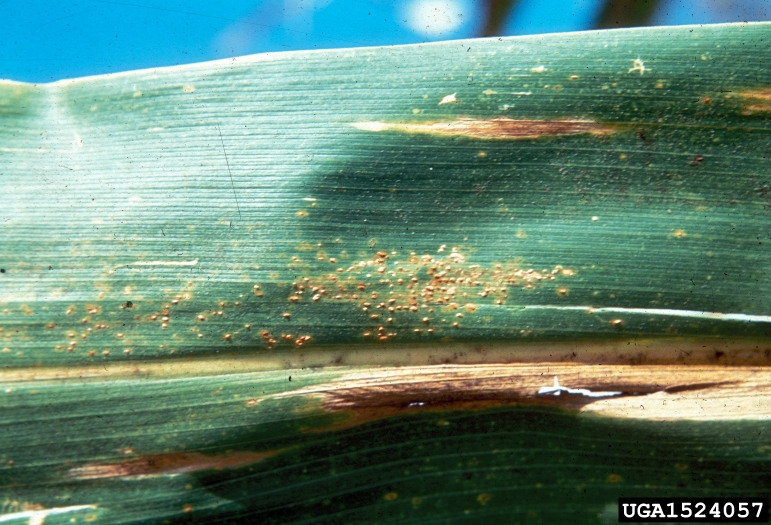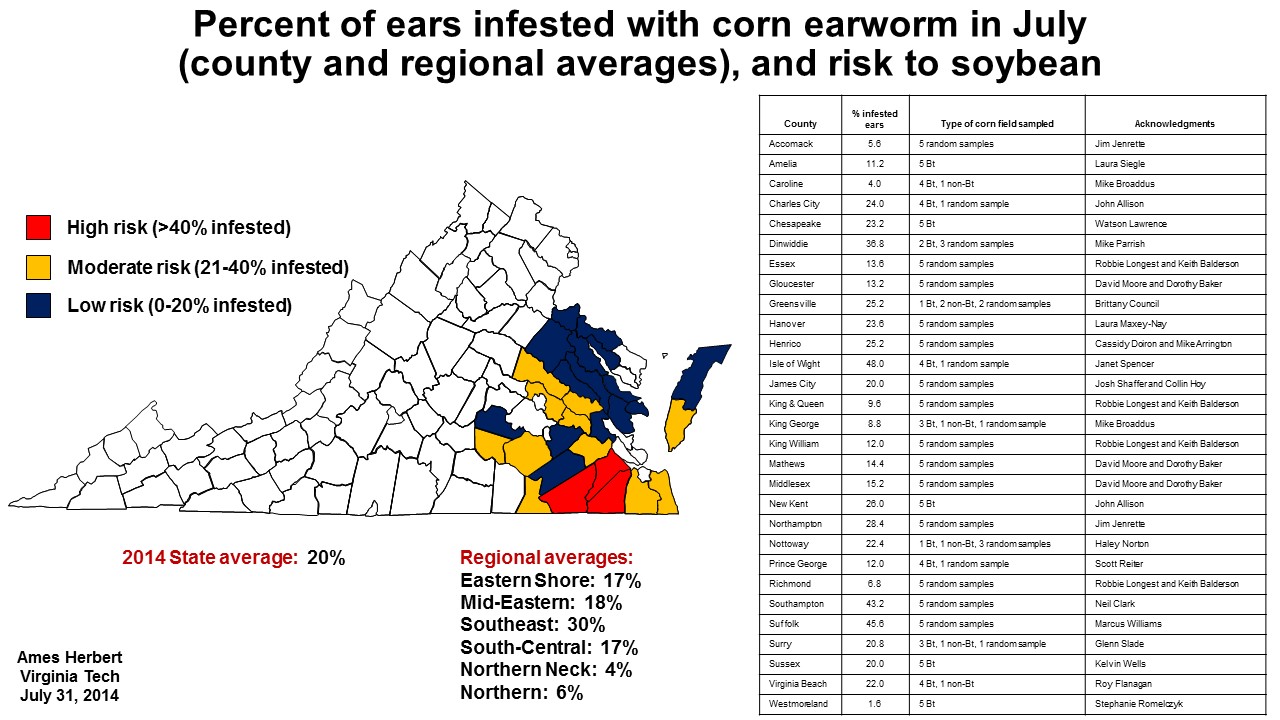Southern rust was confirmed August 3 on corn samples from Chesapeake and Suffolk. Yield of corn at or near the dent stage is unlikely to be impacted by the disease, but less mature corn in the region may need to be protected with a fungicide application. Strobilurins are good preventative fungicides whereas triazoles are recommended once sporulation is observed in a field due to their curative activity. A combination fungicide is a good option as long as a strobilurin fungicide has not been applied previously. Wet, warm weather favors disease development. Once sporulation occurs, symptoms of rust are relatively obvious. Lesions start out as raised, blister-like pustules then break open to reveal orange spores. Samples of corn plants with symptoms of southern rust can be submitted to the disease clinic at the Virginia Tech Tidewater AREC (contact Dr. Hillary Mehl, hlmehl@vt.edu).
Category Archives: Field Corn
Results of the Corn Earworm Survey in Virginia Field Corn—2014
Annually, we conduct a survey to estimate Helicoverpa zea (corn earworm) infestation levels in field corn in mid- to late July. Corn is considered a nursery crop for corn earworm, allowing the pest to complete a lifecycle and then move on to other crops such as soybean, cotton, and peanut in August. Over 30 years of data show that there is a linear correlation between the infestation level in corn and the amount of soybean acreage that gets treated with insecticide for this pest.
To conduct the survey this year, the number of corn earworms found in 50 ears of corn was recorded in 5 corn fields in each of 29 counties, totaling 7,250 ears and 145 fields sampled. When fields were known to contain Bt or non-Bt corn, this was noted. Otherwise, samples were considered to be random and assumed to be representative of the actual Bt/non-Bt composition in each county. Age of corn earworms, or if they had already exited the ears, was also recorded (data not shown). We greatly appreciate the help of Virginia Cooperative Extension Agriculture and Natural Resource (ANR) Agents, Virginia Tech faculty and staff, and volunteers in this effort. These cooperators are acknowledged in the attached Figure. We also would like to thank the many growers who graciously allowed us to inspect their fields for corn earworm.
Results of the survey are provided below (click on the Figure to enlarge it). Statewide, approximately 20% of ears were infested with corn earworm. For comparison, 18% of ears were infested in 2013, 30% in 2012, 33% in 2011; 40% in 2010; and 36% in 2009. Regional averages for 2014 were 6% infested ears in Northern counties, 4% in the Northern Neck, 18% in Mid-Eastern, 17% in South-Central, 30% in the Southeast, and 17% on the Eastern Shore.
This survey is intended to be a representative sample, not a complete picture. We always recommend scouting individual fields to determine exactly what is happening in terms of corn earworm as well as other pests and crop problems. Also, please check the black light trap reports on the Virginia Ag Pest and Crop Advisory and other reports posted weekly to keep up-to-date on the insect pest situation.
Southern Rust on Corn in North Carolina – Update
Southern rust was confirmed on a sample from Camden County, NC on July 21. At this time, southern rust has NOT been reported in Virginia. Yield of corn at or near the dent stage is unlikely to be impacted by the disease, but less mature corn may need to be protected with a fungicide application. Contact your local extension office for recommendations if you suspect southern rust is in your area. Samples of corn plants with symptoms of southern rust should be submitted to your local extension office or the disease clinic at the Virginia Tech Tidewater AREC (contact Dr. Hillary Mehl, hlmehl@vt.edu). Typically the disease has little impact on Virginia corn since it arrives too late in the season to affect yield, but if southern rust is confirmed in Virginia prior to corn reaching the dent stage (R5), fungicide applications may be warranted. Updates will be provided as more information is obtained.
Southern Rust on Corn in North Carolina
Southern rust, a potentially devastating disease of corn, has been reported from several counties in North Carolina. At this time, southern rust has NOT been reported in Virginia. Samples of corn plants suspected to be infected with southern rust should be submitted to your local extension office or the disease clinic at the Virginia Tech Tidewater AREC (contact Dr. Hillary Mehl, hlmehl@vt.edu). Signs of the disease are pustules filled with powdery masses of orange spores (see attached photo). Typically the disease has little impact on Virginia corn since it arrives too late in the season to affect yield, but if southern rust is confirmed in Virginia prior to corn reaching the dent stage (R5), fungicide applications may be warranted. Updates will be provided as more information is obtained. Additional information: southern-rust-on-corn-jpg

Southern Rust on Corn in North Carolina
Southern rust, a potentially devastating disease of corn, has been reported from several counties in North Carolina. At this time, southern rust has NOT been reported in Virginia. Samples of corn plants suspected to be infected with southern rust should be submitted to your local extension office or the disease clinic at the Virginia Tech Tidewater AREC (contact Dr. Hillary Mehl). Signs of the disease are pustules filled with powdery masses of orange spores (see attached photo). Typically the disease has little impact on Virginia corn since it arrives too late in the season to affect yield, but if southern rust is confirmed in Virginia prior to corn reaching the dent stage (R5), fungicide applications may be warranted. Updates will be provided as more information is obtained.
Be careful if you are planning to tank mix Admire Pro with a starter/pop-up liquid fertilizer
Admire Pro applied as a liquid into the seed furrow is proving to be an excellent option for controlling thrips in cotton and peanuts. To increase efficiency, growers are beginning to look at the options for tank mixing other planting time products with the Admire Pro including different starter/pop-up liquid fertilizers. We have information that suggests that there are some combinations that are not working well.
For example, we did a field trial last summer and found that Admire Pro did NOT mix well with 10-34-0 (N-P-K). Where Ca(NO3)2 tank mixed with the Admire Pro with no problem and provided good seedling vigor and good thrips control, the 10-34-0 (N-P-K) Admire Pro tank mix did not. The Admire Pro 10-34-0 mix clotted up and caused clogginh of sprayer lines and nozzle screens. Not unpredictably, seedling vigor and thrips control were also compromised.
We recently had the same experience with a local grower. Before (thankfully) adding Admire Pro to a full load of 3-15-19, (N-P-K) starter/pop-up fertilizer we did a ‘jar’ test. We saw the same result as we did the previous summer in our field trial—that the Admire Pro clotted up in the jar and quickly precipitated out in whitish flakes to the bottom of the jar—not good.
We are beginning a project to evaluate other fertilizer products in lab ‘jar’ test mixes and will take some of these to the field this summer to look at how these mixes perform, both in terms of seedling growth enhancement and thrips control. In the meantime we STRONGLY recommend that if you are planning to tank mix Admire Pro with a starter/pop-up fertilizer that you do a ‘jar’ test to check for compatibility. And, based on our experiences, when filling the spray tank you should add the water first, then the fertilizer, then the Admire Pro last. Continual tank agitation may also be helpful to minimize the risk of any settling of the suspension.
Ames Herbert and Hunter Frame, VT, Tidewater AREC
Black light trap catches for week ending Sep. 5, 2013
Some of the higher corn earworm moth nightly averages were 37 (Dinwiddie-Old Hickory) and 66 per night (Charles City), but other reports were much lower (most were below 5 per night). Brown marmorated stink bug were caught in Petersburg (3.4 per night), Dinwiddie (1.1 per night in Old Hickory), and Warsaw (0.4 per night). Please click “More” for the complete tables. Thanks to the following for their reports this week: John Allison, Chris Drake, Mary Beahm, Scott Reiter, Mark Kraemer, Mike Parrish, and Ames Herbert and crew. Additional information: sep5blt-pdf
Results of the 2013 corn earworm survey of field corn
Attached (click “More”) are the results of Dr. Herbert’s 2013 corn earworm survey of field corn in Virginia. In general, numbers of ears infested with earworm larvae were lower than in previous years. Hopefully this means fewer moths that emerge, leave this nursery crop, and lay eggs in soybean, cotton, peanut, etc. Our network of black light traps will help you determine moth flight activity in your area. It is also vital to scout your crops and use appropriate thresholds for eggs or larvae. For soybean, please use the Corn Earworm Economic Threshold Calculator found at http://webipm.ento.vt.edu/cew/ For cotton you should use the appropriate thresholds (conventional or genetically-protected) found in the 2013 Virginia Cooperative Extension Field Crops Pest Management Guide (beginning on page 4-108 found at http://pubs.ext.vt.edu/456/456-016/Section_4_Insects-11.pdf). Other insect chapters (soybean, peanut, sorghum, etc.) of the Field Crops Pest Management Guide, with appropriate thresholds, can be found at http://pubs.ext.vt.edu/456/456-016/456-016.html Additional information: cew-survey-results-2013-pdf
i’m sorry, I forgot to include Dr. John Tooker’s contact information
Deadline bullets on EPA chopping block (read Dr. Tookers article below)
Metaldehyde (Deadline products) labeled use in corn and soybeans in jeopardy
One of the reasons that slugs are such a challenge in no-till field crops is the lack of commercially available pest management tools. Among the few viable options for slug control are metaldehyde-based baits, the best well known of which are the Deadline products (e.g., Deadline Bullets and Deadline Mini-Pellets), but others are available.
The active ingredient metaldehyde is produced by a European company called Lonza and needs periodic re-registration with the Environmental Protection Agency (EPA). The latest re-registration is underway, and we recently learned that Lonza has decided to let corn and soybeans drop from the label. The IR-4 Project (which facilitates registration of pest management tools; http://ir4.rutgers.edu/) has submitted a petition to EPA to establish tolerances on these and other commodities (which would allow their continued registration on the metaldehyde label), but in the near future it could be that growers would not be allowed to use metaldehyde-based products to protect their corn and soybean fields for perhaps a year or two until the EPA publishes a final rule on the proposed tolerances.
Since learning of this problem, various organizations including IR4, AMVAC (the producer of Deadline products), and University-based and NRCS personnel have mobilized to try to maintain uninterrupted use of metaldehyde in corn and soybeans. Our efforts are directed toward the EPA, where the final decision lies. It is promising that such a range of voices have emerged in support of maintaining the current uses of metaldehyde, but it would be valuable for EPA to hear from growers and grower groups. If you have the energy to send them a note, please contact me by email or phone (814-865-7082) and I can help you make this happen.
Contact Information
John Tooker


